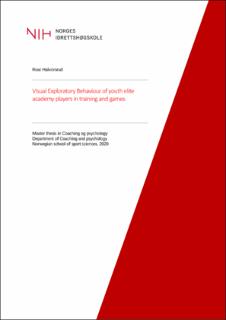Visual Exploratory Behaviour of youth elite academy players in training and games
Master thesis
Permanent lenke
https://hdl.handle.net/11250/2678421Utgivelsesdato
2020Metadata
Vis full innførselSamlinger
Sammendrag
The overall purpose of this study was to examine the visual exploratory behaviour on elite youth academy players during a normal week of training and in one game. The study is a real-world study and Gibson’s (1979) ecological approach to visual perception was used as framework. I followed 3 male (aged 15 years) academy players from and Norwegian premier league club for 3 training sessions and one game. The aim was to investigate if the visual exploratory behaviour in training is aligned with what they do in games. The players where filmed with a high definition camera to get “closeup” video footage. The study also looked at player`s performance and the contextual factor of opponent pressure. The players where analysed frame by frame in Scratch play.
Results revealed that Rondo had lower visual exploratory behaviour than other training exercises such as ball possession games, game training and matches. However, there was no statistical significance found the results were trending towards significance. The visual exploratory behaviour of the player does not always align with the behaviour in matches. This suggests that different training exercises affect the visual exploratory behaviour in different ways. This study was an exploratory study so only cautious conclusions can be made. However, I hope the study can inspire more hypotheses and more research on an interesting area that have yet not been much explored despite football players spending most of their time on the training field.
Beskrivelse
Masteroppgave - Norges idrettshøgskole, 2020
